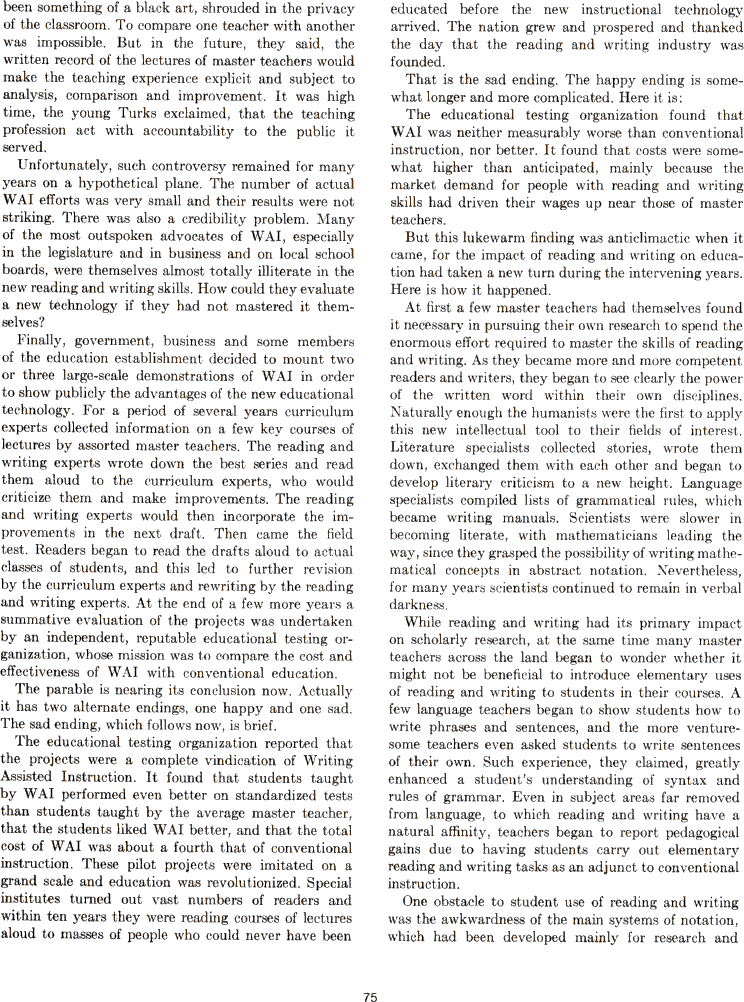The Best of Creative Computing Volume 2 (published 1977)
Should the Computer Teach the Student, or Vice-Versa?

been something of a black art, shrouded in the privacy of the classroom. To
compare one teacher with another was impossible. But in the future, they said,
the written record of the lectures of master teachers would make the teaching
experience explicit and subject to analysis, comparison and improvement. It was
high time, the young Turks exclaimed, that the teaching profession act with
accountability to the public it served.
Unfortunately, such controversy remained for many years on a hypothetical plane.
The number of actual WAI efforts was very small and their results were not
striking. There was also a. credibility problem. Many of the most outspoken
advocates of WAI, especially in the legislature and in business and on local
school boards, were themselves almost totally illiterate in the new reading and
writing skills. How could they evaluate a new technology if they had not
mastered it themselves?
Finally, government, business and some members of the education establishment
decided to mount two or three large-scale demonstrations of WAI in order to show
publicly the advantages of the new educational technology. For a period of
several years curriculum experts collected information on a few key courses of
lectures by assorted master teachers. The reading and writing experts wrote down
the best series and read them aloud to the curriculum experts, who would
criticize them and make improvements. The reading and writing experts would then
incorporate the improvements in the next draft. Then came the field test.
Readers began to read the drafts aloud to actual classes of students, and this
led to further revision by the curriculum experts and rewriting by the reading
and writing experts. At the end of a few more years a summative evaluation of
the projects was undertaken by an independent, reputable educational testing
organization, whose mission was to compare the cost and effectiveness of WAI
with conventional education.
The parable is nearing its conclusion now. Actually it has two alternate
endings, one happy and one sad. The sad ending, which follows now, is brief.
The educational testing organization reported that the projects were a complete
vindication of Writing Assisted Instruction. It found that students taught by
WAI performed even better on standardized tests than students taught by the
average master teacher, that the students liked WAI better, and that the total
cost of WAI was about a fourth that of conventional instruction. These pilot
projects were imitated on a grand scale and education was revolutionized.
Special institutes turned out vast numbers of readers and within ten years they
were reading courses of lectures aloud to masses of people who could never have
been educated before the new instructional technology arrived. The nation grew
and prospered and thanked the day that the reading and writing industry was
founded.
That is the sad ending. The happy ending is somewhat longer and more
complicated. Here it is:
The educational testing organization found that WAI was neither measurably worse
than conventional instruction, nor better. It found that costs were somewhat
higher than anticipated, mainly because the market demand for people with
reading and writing skills had driven their wages up near those of master
teachers.
But this lukewarm finding was anticlimactic when it came, for the impact of
reading and writing on education had taken a new turn during the intervening
years. Here is how it happened.
At first a few master teachers had themselves found it necessary in pursuing
their own research to spend the enormous effort required to master the skills of
reading and writing. As they became more and more competent readers and writers,
they began to see clearly the power of the written word within their own
disciplines. Naturally enough the humanists were the first to apply this new
intellectual tool to their fields of interest.
Literature specialists collected stories, wrote them down, exchanged them with
each other and began to develop literary criticism to a new height. Language
specialists compiled lists of grammatical rules, which became writing manuals.
Scientists were slower in becoming literate, with mathematicians leading the
way, since they grasped the possibility of writing mathematical concepts in
abstract notation. Nevertheless, for many years scientists continued to remain
in verbal darkness.
While reading and writing had its primary impact on scholarly research, at the
same time many master teachers across the land began to wonder whether it might
not be beneficial to introduce elementary uses of reading and writing to
students in their courses. A few language teachers began to show students how to
write phrases and sentences, and the more venturesome teachers even asked
students to write sentences of their own. Such experience, they claimed, greatly
enhanced a student's understanding of syntax and rules of grammar. Even in
subject areas far removed from language, to which reading and writing have a
natural affinity, teachers began to report pedagogical gains due to having
students carry out elementary reading and writing tasks as an adjunct to
conventional instruction.
One obstacle to student use of reading and writing was the awkwardness of the
main systems of notation, which had been developed mainly for research and


